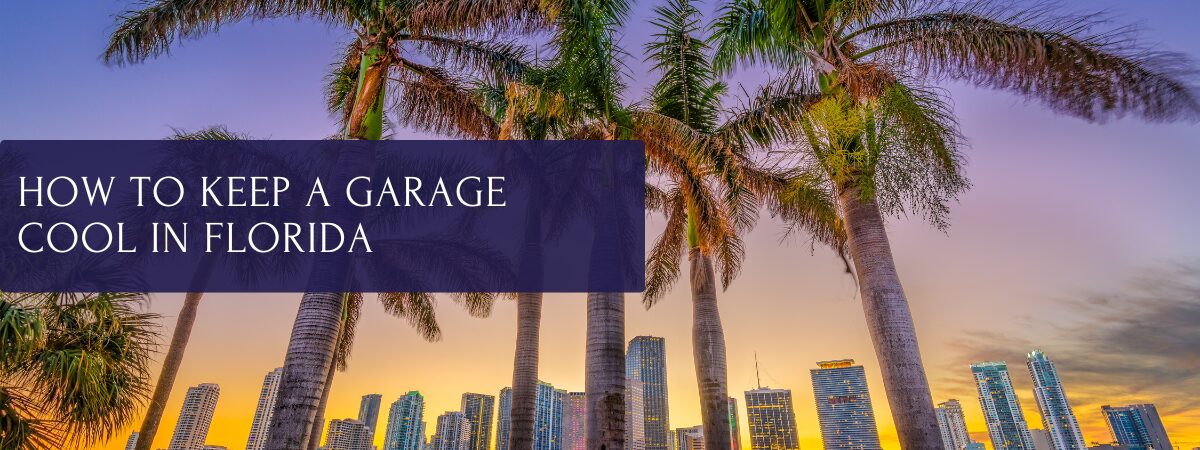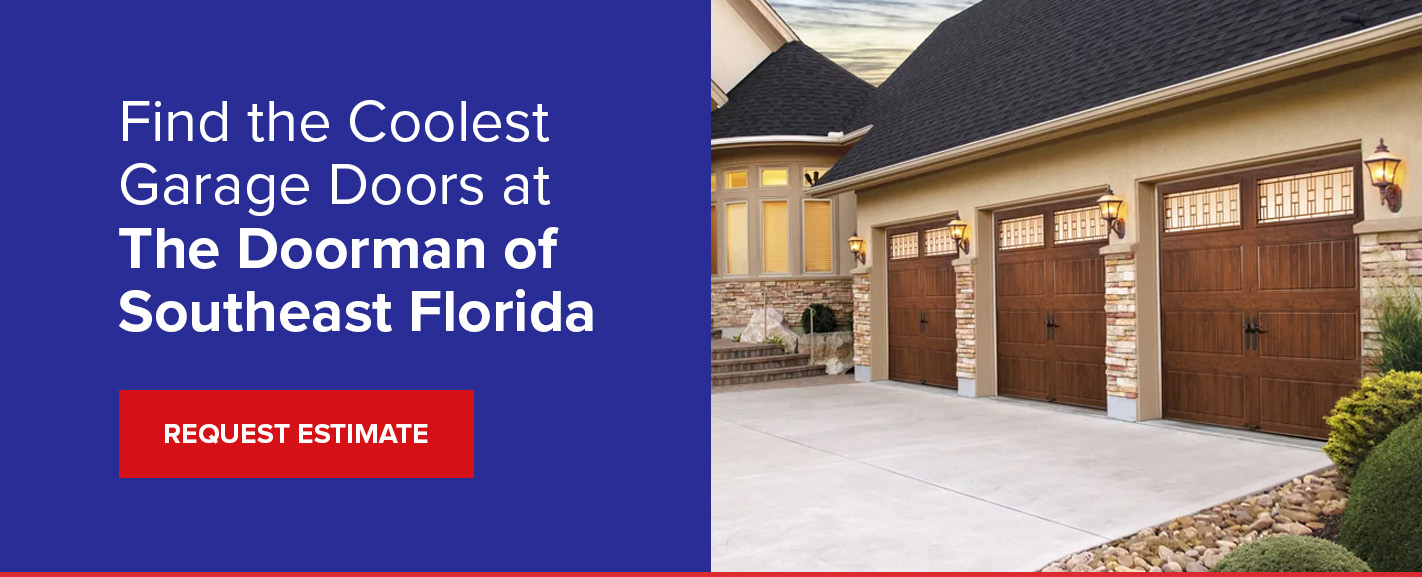The weather in the Sunshine State lives up to its nickname. The high temperatures Floridians experience year-round have pros and cons. While you can enjoy the state’s outdoor attractions year-round, the heat can affect your home’s comfort.
Keeping your garage cool is crucial when the temperatures rise. When it’s hot outside, the inside of your garage can feel like a sauna. Finding ways to maintain a comfortable temperature is a necessity when you live in Florida.
Follow this helpful guide to learn how to keep a garage cool in Florida.
Call Us For Garage Door Installation
Why Do Garages Get Hot?
Garages take a beating from the elements outside and heat-generating items inside. The following contribute to a hot garage.
Insulation
Does garage door insulation reduce heat? In a way, yes — a well-insulated garage prevents hot air from entering your garage and cool air from escaping. Any gaps or cracks under doors, windows or walls can allow hot air inside. Sealing these gaps and adding insulation can protect your garage from unwanted heat, making it more comfortable.
Ventilation
Insufficient ventilation is common in many garages, especially those that lack windows. The air can feel heavy and thick when you have little to no circulation in a hot garage. Improving airflow can make a significant difference in your garage’s temperature.
Location
Your garage’s position impacts the temperature depending on the level of sun exposure. Expect rising interior temperatures if your garage is in direct sunlight all day.
Exterior Paint Color
The color of your garage’s exterior can influence how warm it gets. Dark shades like black, dark blue or gray can increase the heat levels inside your garage. A dark exterior and the direct Florida sunlight create the ideal conditions for a sweltering garage.
Vehicles and Appliances
What you store inside your garage can cause higher temperatures. Parking a recently driven car in your garage raises heat levels. Using a washer and dryer inside your garage during the hot months can also impact the temperature.
Why Cool Your Garage?
An enclosed garage is more than a place to park your car or store belongings. A garage can also be a home office or a spot to enjoy hobbies.
If you use your garage for any of these activities, keeping it cool can enhance the usability:
- Workshop: A garage workshop houses all your tools, workbenches and other resources.
- Exercise gym: Some homeowners transform their garage into a home gym. It provides plenty of space for gym equipment, but avoiding heatstroke is essential when working out.
- Hobbies: Your garage is ideal for painting, developing photos, drawing or sewing. A comfortable and relaxing environment lets you focus on the hobby, not the heat.
- Laundry: Placing your washer and dryer in the garage saves space in your home. Folding laundry in a cool space makes this chore more pleasant.
- Home office: Working from home has gained popularity in recent years. While a garage makes an effective home office, heat can affect concentration and productivity.
How to Cool Down a Garage in Florida
Your home should be a haven to escape the Florida heat and humidity. Try these 10 cooling ideas to keep your garage at a comfortable temperature.
1. Install a Light-Colored Garage Door
Does your garage door face direct sunlight? A lighter-colored door can help lower the heat inside the garage. You could also paint your home’s exterior a lighter shade.
When buying a new residential garage door, consider the windows. Windows allow more sun and heat into your garage. Choosing a solid door keeps your garage cooler. Speak to a reputable garage door service provider to recommend the right door for your home.
2. Open the Windows in Your Garage
If you have windows in your garage, open them to allow air circulation. A lack of breeze or air flow in your garage can make your enclosed space feel stuffy or intolerable. Adding windows to a windowless garage improves ventilation and cools the interior. A window can transform your garage into a pleasant space for working, exercising or spending time on hobbies.
3. Let Your Car Cool Down
A simple, effective cooling hack for your garage is to park your car outside after using it. Your car radiates significant heat when running and after you use it, raising the temperature inside your garage. Your garage floors absorb the heat and warm the space long after the car is off. Let your vehicle cool outside the garage before moving it inside.
4. Use Your Garage in the Morning
Plan your garage activities during the coolest part of the day — for example, before 11 a.m. or after 6 p.m. You could also open your garage door for a few minutes before using the space. Letting warm air escape can make your workout or working day more comfortable.
5. Place Fans Inside Your Garage
A simple fan is an effective and budget-savvy way to improve air circulation in your garage. Instead of investing in expensive ventilation, insulation or air conditioning, use fans first. Box fans, oscillating fans or heavy-duty shop fans can make a noticeable difference. Position fans to encourage air movement. You can even place a fan in a window to blow hot air outside. While it may not affect the inside temperature, the moving air will feel better than stagnant, hot air.
6. Upgrade the Ventilation System
If the outside temperature often feels better than the inside of your garage, it’s a clear sign that your ventilation system needs an upgrade. Insufficient ventilation traps hot air, making the space uncomfortable.
Try these garage ventilation tips for hot weather:
- Maximize airflow: Open windows or doors to promote natural airflow. This cross-ventilation allows outside air to circulate and push out hot, stagnant air.
- Install a ventilation system: Consider a passive or active ventilation system to exchange hot air with cooler outside air. A passive system uses natural forces rather than electricity to circulate air. Active ventilation relies on electrical components like fans or blowers.
- Time your ventilation: Ventilate during cooler parts of the day, like early morning or late evening.
7. Enhance Insulation
The temperature of neighboring rooms or the outside can impact your garage interior. Many garages lack proper insulation, which can lead to significant temperature fluctuations. Adding insulation helps to regulate the temperature and maintain a more comfortable environment.
In addition to insulation, seal any cracks or gaps in the garage to prevent cool air from escaping. Use caulk and weatherstripping to close gaps around windows, doors, and other openings.
8. Consider Air Conditioning
For consistent temperature control that matches the rest of your home, air conditioning is a viable option. The ideal solution depends on your budget. Window-mounted units are a smaller, budget-friendly choice for spot cooling. Ductless AC systems offer a more comprehensive solution for enclosed garages. Remember to factor the energy consumption of AC units into your decision.
9. Declutter and Organize
Decluttering and organizing your garage helps keep it cool by promoting better airflow. Mess obstructs the movement of air, trapping heat. Clearing out unnecessary clutter and implementing storage solutions allows air to circulate. This improved airflow helps dissipate heat, preventing it from becoming stagnant and raising the garage’s temperature. An organized space allows for better ventilation, creating a cooler and more enjoyable environment.
10. Invest in a Dehumidifier
Florida’s humid climate can make garages feel even hotter. Dehumidifiers cool your garage by removing excess moisture from the air. High humidity prevents sweat from evaporating, making the air feel hotter and stickier. A drier environment lets your body’s natural cooling mechanisms work. A dehumidifier is an excellent year-round tool to fight against the Florida humidity.
Cool Your Garage With a New Garage Door
Upgrading your garage doors does more than boost curb appeal — it can also cool your garage. Installing a high-quality door contributes to cooling through:
- Improved insulation: Upgrading to an insulated garage door provides a thermal barrier. This barrier stops heat from radiating into the garage during hot weather and keeps the space cooler.
- Better sealing: Professional garage door installation ensures a tight seal around the door. Closing gaps minimizes air leaks and prevents hot air from seeping in.
- Reflective materials: Opt for materials that reflect sunlight. Light-colored steel or composite materials can reduce heat absorption and keep the garage cooler.
- Built-in ventilation: Some upgraded garage doors have built-in ventilation options. Small vents or windows can open to encourage airflow and release trapped heat.
- Reduced heat transfer: Modern garage doors minimize heat transfer through conductive materials. Less heat means a more consistent temperature inside the garage.
Find the Coolest Garage Doors at The Doorman of Southeast Florida
Installing a new garage door is an excellent way to keep your Florida garage cool. At The Doorman, we carry a range of Clopay® garage doors made with Florida’s climate in mind. Trust us for expert garage door installation, repairs and maintenance. Our knowledgeable team can answer your questions and recommend the perfect door for your home.
Contact us today for a free estimate or visit our garage door showroom in Boca Raton.


